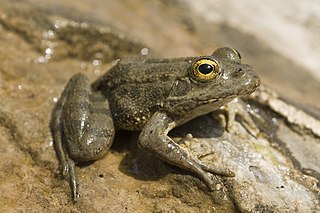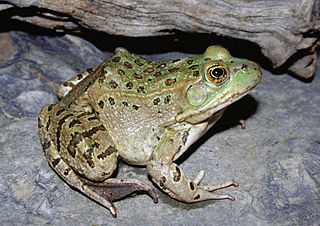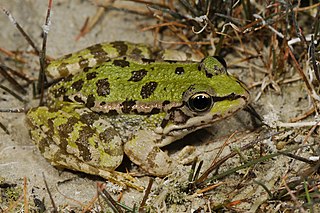
The Italian tree frog is a species of frog in the family Hylidae, found in Italy, Slovenia, Switzerland, and possibly San Marino. Its natural habitats are temperate forests, rivers, intermittent rivers, freshwater marshes, intermittent freshwater marshes, arable land, and urban areas. It is threatened by habitat loss.
Kassina lamottei is a species of frog in the family Hyperoliidae. It is found in Ivory Coast, possibly Guinea, and possibly Liberia. Its natural habitats are subtropical or tropical moist lowland forests and intermittent freshwater marshes. It is threatened by habitat loss.

The Karpathos frog is a species of frog in the family Ranidae. It is endemic to the island of Karpathos, South Aegean Sea, Greece. The Karpathos frog is considered the most endangered anuran amphibian in Europe because its range is restricted to two small rivers in the north part of the island.
The Chaochiao frog is a species of frog in the family Ranidae, found in China and possibly in Myanmar and Vietnam. Its natural habitats are temperate forests, subtropical or tropical moist montane forests, subtropical or tropical high-altitude shrubland, subtropical or tropical high-altitude grassland, rivers, swamps, freshwater lakes, freshwater marshes, intermittent freshwater marshes, ponds, irrigated land, and canals and ditches. It is not considered threatened by the IUCN.

The Asiatic grass frog or Chinese brown frog is a species of frog in the family Ranidae, found in China and Mongolia.
The chevron-spotted brown frog is a species of frog in the family Ranidae, endemic to Mount Emei, Sichuan, China. Its natural habitats are temperate forests, freshwater marshes, and intermittent freshwater marshes. It is threatened by habitat loss.

The Chiricahua leopard frog is a species of frog in the family Ranidae, the true frogs.

The Cretan frog is a species of frog in the family Ranidae. It is endemic to Greece.
The Emei music frog is a species of frog in the family Ranidae. It is endemic to China, and is found in central China, in southeastern Sichuan, northeastern Yunnan and western Guizhou provinces. The species name refers to the type locality, Mount Emei in Sichuan, and its vocalizing abilities. The original name Rana musica was replaced with Rana daunchina as the former name was already taken.

The common green frog is a frog species of in the true frog family Ranidae; some sources still use the old name Rana erythraea. It lives in Southeast Asia and is also known as green paddy frog, red-eared frog or leaf frog. The last name, however, commonly refers to the Neotropical tree frogs which make up the subfamily Phyllomedusinae. These are not closely related to H. erythraea, belonging to family Hylidae instead.

The Greek stream frog, or simply Greek frog, is a species of frog in the family Ranidae found in Albania, Bosnia and Herzegovina, Bulgaria, Greece, North Macedonia, Serbia and Montenegro, and Turkey. Its natural habitats are temperate forests, temperate grassland, rivers, intermittent rivers, freshwater springs, and pastureland. It is not considered threatened by the IUCN.

Humerana lateralis is a species of frog in the family Ranidae. It is found in Cambodia, Laos, Myanmar, Thailand, and Vietnam. It is commonly known as Kokarit frog, yellow frog or (ambiguously) wood frog.

"Hylarana" latouchii, also known as Kuatun frog, LaTouche's frog, or broad-folded frog, is a species of frog in the family Ranidae. It was formerly placed in genus Rana. The specific name honours the collector of the type series: "Hylarana" latouchii was described by George Albert Boulenger based on three specimens collected by Irish ornithologist John D. La Touche in Guadun village in Wuyishan, Fujian, China.

The long-legged wood frog, also known as Caucasus frog, Brusa frog, or Uludağ frog, is a species of frog in the family Ranidae found in Armenia, Azerbaijan, Georgia, Iran, Russia, Turkey, and Turkmenistan.
Glandirana minima is a species of frog in the family Ranidae. It is endemic to the eastern parts of the Fujian province, China,. Its natural habitats are rivers, swamps, freshwater marshes, intermittent freshwater marshes, ponds, and irrigated land. It is threatened by habitat loss.

The Perez's frog, also known as Iberian waterfrog, Iberian green frog, or Coruna frog is a species of frog in the family Ranidae. It is native to southern France, Portugal, Spain, and has been introduced to the Canary and Balearic Islands, Madeira, the United Kingdom, and the Azores. In the Iberian Peninsula it is widespread and common.

The Albanian water frog is a species of true frog and is native to Albania and Montenegro. As its common name suggests, it prefers aquatic environments. The Albanian water frog is an endangered species and known populations are currently in decline. Significant threats to its habitat are presented by pollution and by drainage of wetlands, and a more direct threat is the aggressive collection of the species for commercial purposes.
The Sichuan frog is a species of frog in the family Ranidae found in China and possibly Myanmar. Its natural habitats are temperate shrubland, temperate grassland, rivers, intermittent rivers, swamps, freshwater marshes, and intermittent freshwater marshes.

Vaillant's frog is a species of frog in the family Ranidae found in Central America. Its natural habitats are subtropical or tropical dry forests, subtropical or tropical moist lowland forests, subtropical or tropical swamps, rivers, swamps, freshwater lakes, intermittent freshwater lakes, freshwater marshes, intermittent freshwater marshes, rural gardens, heavily degraded former forests, water storage areas, ponds, and canals and ditches.
Rana zhengi is a species of frog in the family Ranidae that is endemic to Sichuan, China.














